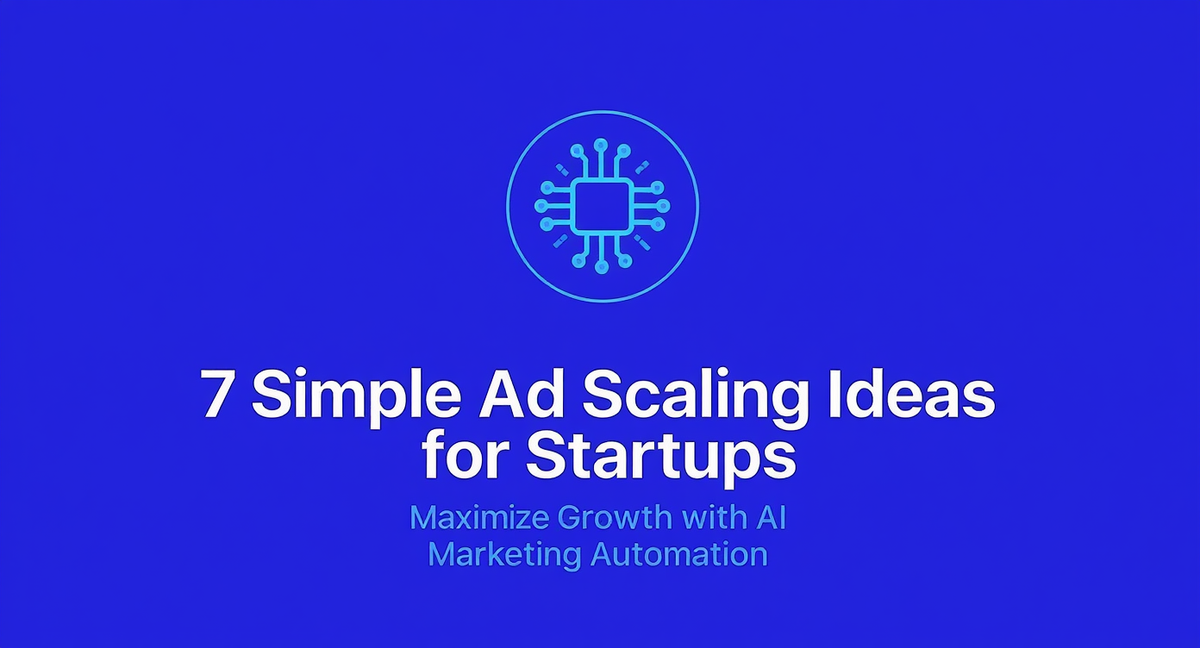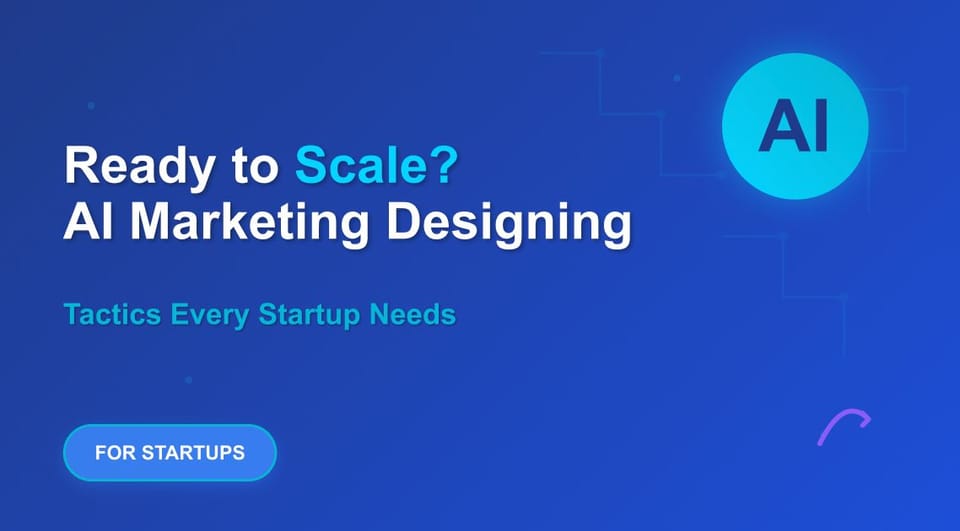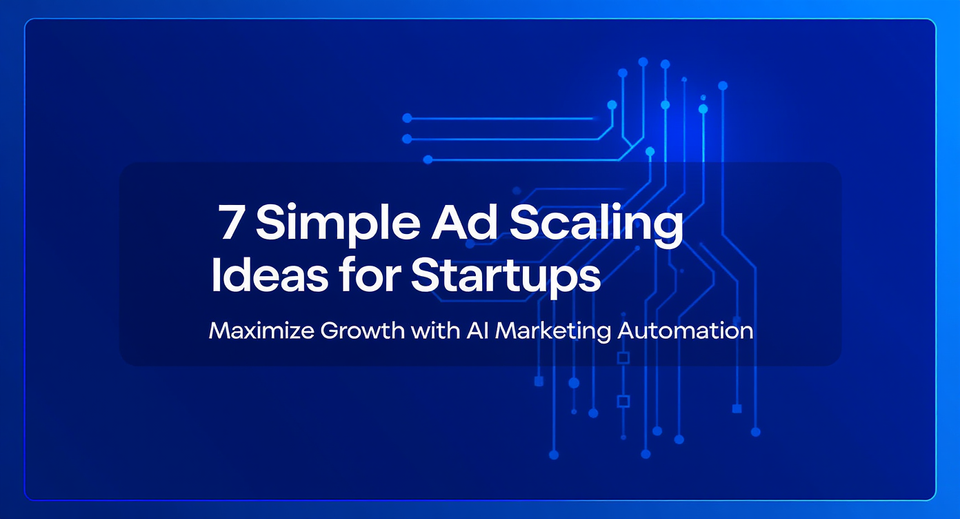7 Simple Ad Scaling Ideas for Startups: Maximize Growth on a Budget

In today's competitive digital world, startups face the tough task of growing their advertising while having few resources. Being able to scale ads efficiently can make the difference between fast growth and staying the same. This guide looks at seven proven ad scaling ideas to help startups get the most out of their ads without spending too much.
1. Creative-Led Growth: A New Way to Scale Ads
Advertising has changed a lot. Platforms like Meta, Google, and LinkedIn now focus more on creative relevance instead of simply targeting specific audiences. This means traditional ways of running ad campaigns—using only a few ad types and targeting small groups—are not as effective as before.
For startups looking to grow easily, focusing on making many high-quality creative ads that connect with different audiences is key. SurgeGrowth's AI tool helps startups create thousands of personalized ad creatives quickly and in line with their brand, making it easy to use a creative-led growth approach without overwhelming the team.
2. Algorithmic Optimization: Working With the Platforms
Successful ad scaling means knowing how platform algorithms work and adjusting campaigns accordingly. Instead of fighting against these algorithms, startups should work with them.
Important strategies for algorithmic optimization include:
- Combining ad sets to give algorithms more data
- Using broad targeting to help algorithms find the best audiences
- Using campaign budget optimization to move money to the best ad sets
- Avoiding frequent edits to keep learning consistent
- Focusing on making many different creative ads rather than targeting specific audiences
By using algorithmic optimization, startups can scale more efficiently without constantly making manual changes that waste resources.
3. Personalized Creativity at Scale
Personalized ads get more attention, but it can be hard to make these ads for a large audience without spending a lot. Today's best scaling ideas use technology to personalize ads for many people.
Good personalized ad ideas include:
- Making ads that fit well with different locations
- Using value propositions that connect with different audience groups
- Making different creative ads based on behavior
- Using clear calls-to-action based on what people want
- Including product details in the ads
SurgeGrowth's dynamic creative templates let startups try out different messages, visuals, and call-to-actions for testing and customization without needing lots of design help.
4. Automatic Marketing Workflows
Making ads is often the slowest part of scaling ad campaigns. Traditional ways of doing this with many people, approvals, and manual work can't keep up with the number of ads needed.
Automatic marketing workflows fix this by:
- Making approval faster using one platform
- Using templates to keep the brand look while trying different things
- Using AI to make lots of ad versions from the main ideas
- Automatically changing ad formats for different platforms (stories, feeds, etc.)
- Making changes quickly based on how ads perform
5. Changing Creativity for Different Platforms
Efficient ad scaling means being on many platforms, each with different needs and best practices. Changing ads for each platform takes time and people.
Modern scaling ideas include:
- Resizing and changing formats for different platforms
- Making ads that work best on each platform
- Keeping messages consistent but changing how they look on each platform
- Tracking performance on every platform to learn more
- Using one platform to manage creative ads
This way, startups can be on all platforms without working more, making sure time and money are used well while reaching more people.
6. Trying New Ideas Based on Performance
Old ad strategies don't use what's learned from ads in real-time. Efficient ad scaling means making ads better all the time using data.
Doing this well includes:
- Finding what works in ads using detailed data
- Making more versions of ads that worked well
- Testing new ideas based on data
- Connecting how ads do with how the team is working
- Setting goals for good ads beyond what is usually measured
By having clear ways to test ads, startups can always get better results as they spend more on ads.
7. AI-Powered Creative Knowledge
The best ad scaling ideas now use artificial intelligence not just to make ads, but to know what works and why.
AI-powered creative knowledge includes:
- Seeing patterns in successful ads
- Predicting how well ads will do
- Getting ideas from data on how ads are doing
- Checking what others are doing in their ads
- Finding new trends and things to try
SurgeGrowth combines easy creative workflows with high-quality outputs, making it simple to make ads tailored for location, audience type, intent, or behavior while keeping the ads great.
Implementation Phases
To use these easy ad scaling ideas, startups should do it in steps:
Phase 1: Make a good base for creative ads with templates and rules that help with scaling while keeping the brand look the same.
Phase 2: Use workflows that are automatic to make ads faster and try different things more.
Phase 3: Have a system to test ads that keeps making them better while spending more money.
Phase 4: Use AI and other tech to make personalized ads for many people without needing lots of resources.
Phase 5: Connect how ads do with how everything is working to keep growing well.
The Future of Ad Scaling for Startups
As platforms use AI more to send ads, the startups that do well will focus on being creative to scale. Instead of thinking about targeting people or spending more money than others, successful startups will win by using creative ads that connect with people, making personalized ads for many people, and working with how platforms choose which ads to show.
With tools like SurgeGrowth's AI tool, startups can make a lot of personalized ad creatives quickly and in line with their brand. This way, they can grow easily with creative-led growth—turning what was once a big challenge into a way to win.
By using these seven easy ad scaling ideas, startups can grow steadily without needing to spend a lot more money—the main goal of any scaling strategy.
Citations
- Meta Business Help Center. "About Advantage+ Campaigns." https://www.facebook.com/business/help/860148161860601
- Google. "Performance Max campaigns." https://support.google.com/google-ads/answer/10724817
- Harvard Business Review. "The New Analytics of Advertising." https://hbr.org/2022/03/the-new-analytics-of-advertising
- McKinsey & Company. "The value of getting personalization right—or wrong—is multiplying." https://www.mckinsey.com/capabilities/growth-marketing-and-sales/our-insights/the-value-of-getting-personalization-right-or-wrong-is-multiplying
- Nielsen. "The Nielsen Annual Marketing Report." https://www.nielsen.com/insights/2022/the-nielsen-annual-marketing-report-era-of-alignment/
FAQs
Q: How much should startups invest in ad scaling technology?
A: Startups should use 15-20% of their marketing budget on scaling technologies that can make things faster, with the investment usually paying for itself within 3-6 months.
Q: Can small startups with not much money use these ad scaling ideas? A: Yes, a lot of these ideas can start small and get bigger as your business grows. Start with easy creative scaling and algorithmic optimization before moving to more advanced AI solutions.
Q: How fast will startups see results from using easy ad scaling ideas? A: Improvements should show up within 2-4 weeks, with bigger benefits coming after 2-3 months of working consistently with these ideas.
Q: Can creative-led growth work for everyone?
A: Yes, while each industry might have different ways of doing this, the main idea of using creative ads that platforms like is true for nearly all digital advertising and business types.
Q: How can startups see if these ad scaling ideas are working well?
A: Other than usual measures like how much money made back on ads and how much it costs to get one buyer, startups should track how many ads are made, how quick the team can try new things, and how creativity and performance connect to know if things are going well.




